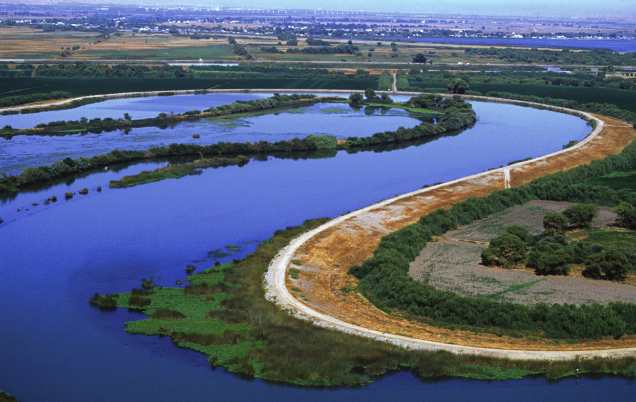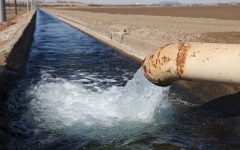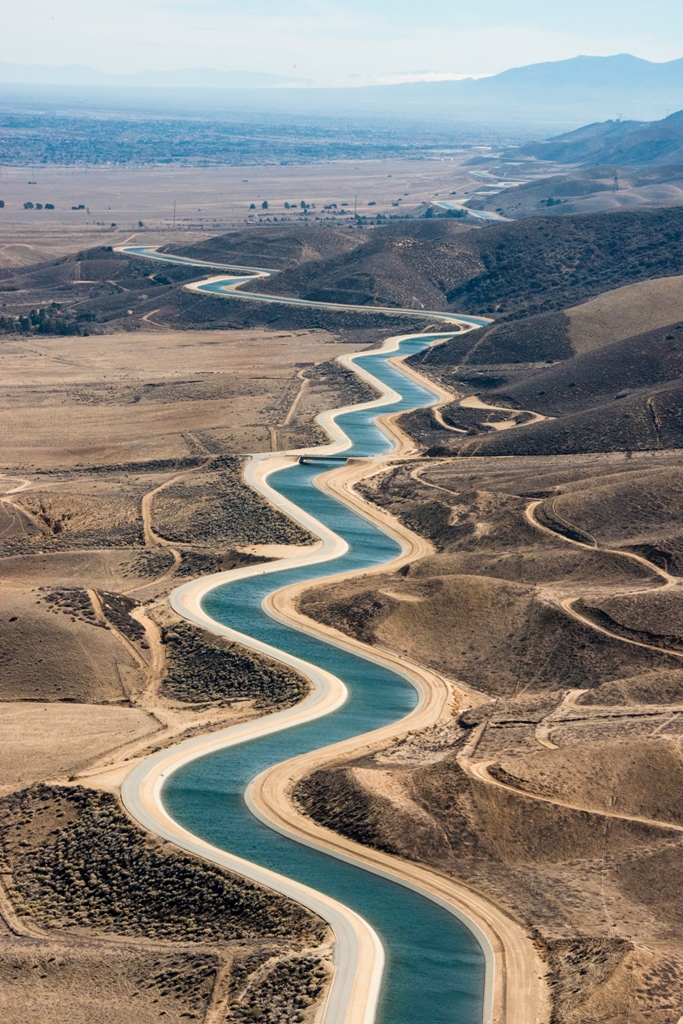
California Bay Delta water (Photo: USGS.gov)
Ringside: Ways California Can Have Abundant Water
Many solutions require no public money, just permission
By Edward Ring, October 31, 2024 2:58 am
 A few years ago a group of volunteers, myself included, attempted to qualify a state ballot initiative called “The Water Infrastructure Funding Act.” Those of us involved with this project remain convinced that had it qualified for the ballot and been approved by voters, it would have solved water scarcity in California forever. Included within this 8,071 word magnum opus was a requirement for 2 percent of the State General Fund to be allocated for water supply projects, with annual funding to continue until new (and completed) water supply projects yielded 5 million acre feet of water per year.
A few years ago a group of volunteers, myself included, attempted to qualify a state ballot initiative called “The Water Infrastructure Funding Act.” Those of us involved with this project remain convinced that had it qualified for the ballot and been approved by voters, it would have solved water scarcity in California forever. Included within this 8,071 word magnum opus was a requirement for 2 percent of the State General Fund to be allocated for water supply projects, with annual funding to continue until new (and completed) water supply projects yielded 5 million acre feet of water per year.
Writing the initiative took nearly a year, and relied on expert help from attorneys recruited from farming interests, urban water agencies, civil engineering contractors, and construction unions. The measure would have allowed half of the annual 2 percent budget allocation to be used to finance bonds, unlocking billions in funds for immediate construction. It redefined “beneficial use” to include agricultural and urban consumption, it streamlined CEQA requirements, and it included as eligible for funding virtually every type of project that might increase our water supply.
The measure, probably because it was being taken seriously by people with the wherewithal to get it onto the ballot, incurred the immediate condemnation of environmental groups. For these groups, nonnegotiable transgressions were to include surface reservoirs and ocean desalination as projects eligible for funding, along with any attempt to tamper with CEQA. Polling indicated strong support from voters, right up until any suggestion of environmental damage was made, wherein support collapsed. The initiative campaign did not gather enough signatures to qualify for the state ballot, and California remains headed for water rationing.
Just as with energy, however, Californians do not have to live with water scarcity. Here are the messages that we hope will eventually animate a critical mass of influential Californians:
- Abundant water is feasible and sustainable,
- Reasonable environmentalism is compatible with abundance,
- An all-of-the-above approach to types of water supply projects guarantees resilience,
- State and federal funds, along with private sector funds, are needed to upgrade and expand water supply infrastructure; the local rate base is not enough,
- To win politically, urban and rural water interests must unite behind a common policy and project agenda.
There are a lot of ways to summarize the quantities of water that Californians receive and manage, starting with what enters the system each year as rain and snow. According to data compiled by the California Department of Water Resources, over the 10-year period from 2011 through 2020, on average California receives about 200 million acre-feet (MAF) of rain each year. Out of that total, California’s water withdrawals for agriculture generally total around 30 MAF/year, and for urban use around 8 MAF/year.
Needless to say, a lot has to happen between water falling from the sky and water irrigating a field or running through a tap. Which is why we need ongoing and major investments in water infrastructure. A lot has changed since the 1950s and 1960s when the California State Water Project and the Federal Central Valley Projects were first built. California’s population has risen to not quite 40 million. And over the past 20 years, as we attempted to protect aquatic habitat by leaving more water in the rivers, in response farmers began pumping up to 20 million acre feet of groundwater per year, causing unsustainable depletion of finite aquifers. What do we do?
The solution is not found in urban rationing. The legislation we have enacted might save up to 400,000 acre feet per year at an estimated cost of $7 billion and an incalculable cost in annoyance. Here, then, are alternatives that may not trigger apoplectic environmentalist opposition.
The solution with the most potential is to find a way to safely divert more water from the Sacramento-San Joaquin Delta when major storms slam into the Sierra Nevada Mountains and dump rain across the state. There’s usually at least one or two big storms even in drought years. For example, between January 1 and March 31 of 2024, 10.3 million acre feet of water flowed through the Sacramento-San Joaquin Delta and out to the ocean. During that same period of time, only 1.35 million acre feet was pumped into southbound aqueducts for use by farms and cities. 2024 was an average water year, and of nearly 12 MAF of flow, only 1.35 MAF was diverted for human use.
The Fish Friendly Delta Diversion proposal may provide this solution. It calls for constructing a levee inside a delta island parallel to the existing outer levee, with openings cut into each end. The channel would be lined and filled with rocks and gravel covering up perforated pipes, sort of like a giant French Drain. This would allow water to flow into the pipes without the potentially destructive impact of pumping. In this way it would not alter the current in the delta and it would not harm fish. A 200 acre site could withdraw up to 15,000 acre feet per day, and the construction cost is estimated to be under $3 billion including conveyances to underground storage.
There was a time in California when a concept with such immense potential would already have been tested, hopefully proven feasible, and built. At a price tag of approximately two billion dollars per million acre feet of annual yield, it is so cheap it could be pursued without cannibalizing funds from other major projects. Why isn’t funding for a Fish Friendly Diversions pilot project explicitly written into the text of Proposition 4? Will a few million fall out of the $3.8 billion allocated for “Drought, Flood, and Water Supply” in order to fast-track a pilot project?
Other water supply projects are far more expensive, but most of them are necessary. Cleaning up and recycling urban wastewater that currently goes into the San Francisco Bay and into the ocean off the Los Angeles coast would cost $20-$30 billion and yield about 1 MAF per year. Building the Delta Conveyance as a hedge against an earthquake turning the delta levees into slurry would also cost $20-$30 billion and might also generate an average yield of 1 MAF per year, depending on the whims of nature, along with the whims of myriad watchdog agencies.
Ultimately, Californians are only limited by their creativity and their financial capacity. Neither ought to be in short supply. It’s a matter of priorities. A land-based brackish water desalination plant costing $1 billion could possibly have an annual capacity somewhere between 50,000 and 100,000 acre feet per year. And, most urgently, let farmers harvest winter floods, tapping millions of acre feet each year from temporarily swollen rivers to recharge their aquifers. That solution, like many others, requires no public money, just permission.
- Ringside: What is the Future of California’s Republican Party? - December 31, 2025
- Ringside: CA GOP Just Blew $46 Million for Nothing – Here’s How They Can Avoid Repeating That Mistake in 2026 - December 24, 2025
- Ringside: Will the Delta Pumps Operate at Capacity this Winter? - December 18, 2025





If Trump wins, we have a four year window to accomplish something with the help of the President of the United States. We’ll know in a week. I don’t think we’ll ever have another President willing to get involved in the California water wars.
Mr. Ring concludes that Californians are only limited by their creativity and their financial capacity and that the solution requires no public money, just permission? That permission will never come as long as Gavin “Hair-gel Hitler” Newsom and his criminal Democrat mafia cronies in the legislature along with their unelected stooges who are installed in nebulous bureaucracies like State Water Resources Control Board have almost complete control over Californians by creating water scarcity?
Please try to get this on the ballot again.
Another item in the Marxist playbook: deciding who and how much water everyone will be allowed to have It’s all about control of this country by any and all means necessary.